|
|
|
Sort Order |
|
|
|
Items / Page
|
|
|
|
|
|
|
| Srl | Item |
| 1 |
ID:
096512
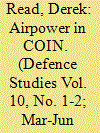

|
|
|
| 2 |
ID:
098413


|
|
|
|
|
| Publication |
2010.
|
| Summary/Abstract |
The authors analyse newly collected time-series data measuring the dimensions of violent political conflict in Egypt. Attention is focused on the interaction between politically motivated attacks by Islamists and the counter-insurgency measures used by the Egyptian government. Both insurgency and counter-insurgency are multidimensional. Insurgency includes attacks on tourists, on Egyptian civilians and on security forces. Counter-insurgency includes arrests and attacks on militants. To some extent, the dynamics of insurgency and counter-insurgency can be described by two distinct cycles of violence: one related to highly politicized activities on both sides, and another related to less explicitly political activities. However, the two cycles are inter-related, leading to complex and asymmetric dynamics in the relationships between the different dimensions of the conflict. The authors find that the combination of political repression and military counter-insurgency measures employed by the Egyptian government has the potential to exacerbate rather than reduce political violence. On the other hand, the overall level of conflict intensity in Egypt can be mitigated by food subsidies. Finally, the existence of significant spillovers from upsurges in the Israeli-Palestinian conflict shows the regional importance of reaching a Middle East peace agreement.
|
|
|
|
|
|
|
|
|
|
|
|
|
|
|
|
| 3 |
ID:
027257
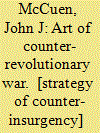

|
|
|
|
|
| Publication |
London, Faber and Faber, 1966.
|
| Description |
349p.
|
|
|
|
|
|
|
|
|
|
|
|
Copies: C:1/I:0,R:0,Q:0
Circulation
| Accession# | Call# | Current Location | Status | Policy | Location |
| 000038 | 355.0218/MCC 000038 | Main | On Shelf | General | |
|
|
|
|
| 4 |
ID:
096511
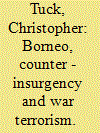

|
|
|
| 5 |
ID:
116256
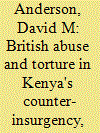

|
|
|
|
|
| Publication |
2012.
|
| Summary/Abstract |
Accusations of abuse and torture in the counter-insurgency campaign against Mau Mau rebels in Kenya were widely publicised during the 1950s. The typical British response was to issue official denials, and when prosecutions did arise the perpetrators were characterised as pathological, their behaviour presented as isolated and exceptional. New evidence found in the British colonial 'Migrated Archive' for Kenya now confirms that the practice of torture and abuse was widespread, amounting to a systematic pattern of state policy. This article rejects dispositional and individual explanations of British torture in Kenya and instead examines the violence in temporal and structural terms, showing how the toleration of violence at an early stage of the Emergency led to its institutionalisation in Kenya's detention camps at a later stage. The article offers evidence from the screening process in the first phase of the counter-insurgency campaign, and from the 'dilution technique' applied in the detention camps after 1956 in the final phase of the war to illustrate the argument. The concluding discussion explores the dilemmas confronting Kenya's colonial violence workers and their political masters as they struggled to present torture as lying within the 'rule of law'.
|
|
|
|
|
|
|
|
|
|
|
|
|
|
|
|
| 6 |
ID:
116260
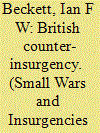

|
|
|
|
|
| Publication |
2012.
|
| Summary/Abstract |
The article aims to offer a survey of the historiographical analysis of British counter-insurgency practices and campaigns since the publication of Armed Forces and Modern Counter-insurgency, edited by the author and the late John Pimlott in 1985. It is argued that the volume in question was influential at a time when there was little academic interest in counter-insurgency in Britain. Moreover, the subject generally had been little studied in Britain in the past beyond work by a handful of military writers and theorists. Arguably, the analytical framework followed in Armed Forces and Modern Counter-insurgency holds its value even after over a quarter of a century. Since the 1980s, however, it has become apparent that the subject is of increasing academic interest, not least in terms of the ongoing debate on the nature and application of the concept of 'minimum force' in British campaigns.
|
|
|
|
|
|
|
|
|
|
|
|
|
|
|
|
| 7 |
ID:
116257
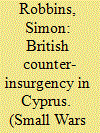

|
|
|
|
|
| Publication |
2012.
|
| Summary/Abstract |
The Cyprus Emergency is often lumped together with Malaya and Kenya as an example of British counter-insurgency practice in the 1950s. Malaya and Kenya in particular are often used as models of how to succeed. The general perception is that these counter-insurgency campaigns, which are often connected with the strategy of 'winning hearts and minds', were highly successful,1
and have 'become synonymous with the conduct of a successful counter-insurgency campaign',2 in contrast with the methods employed by the French in Indo-China and Algeria, the Dutch in Indonesia, the Portuguese in Angola and Mozambique, the Americans in Vietnam, and the Soviets in Afghanistan. However, Cyprus, which tends to be comparatively neglected and less studied, presents a far less rosy and more problematic picture of British counter-insurgency practices in the 1950s. The geography and politics of Malaya and Kenya make them unsuitable as a model for counter-insurgency operations in the very different situation in Cyprus between 1954 and 1959. Rather than the usual comparison with Malaya and Kenya, Cyprus should be seen in parallel not only with Palestine, Aden, and Northern Ireland but also with Portugal and Rhodesia.
|
|
|
|
|
|
|
|
|
|
|
|
|
|
|
|
| 8 |
ID:
116250
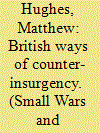

|
|
|
|
|
| Publication |
2012.
|
| Summary/Abstract |
This essay introduces the special issue, drawing together the different studies around the central theme of the nature of the force used by Britain against colonial insurgents. It argues that the violence employed by British security forces in counter-insurgency to maintain imperial rule is best seen from a maximal perspective, contra traditional arguments that the British used minimum force to defeat colonial rebellions. It shows that the use of force became more difficult especially after the Amritsar massacre in 1919. The presence of white settlers in counter-insurgencies - such as in Kenya in the 1950s - accelerated abuse by security forces and complicated the measured use of force against insurgents by the colonial state. The article concludes by drawing lessons from the British experience of counter-insurgency to unconventional military operations today, suggesting that in some situations the use of maximal force is still an option in counter-insurgency.
|
|
|
|
|
|
|
|
|
|
|
|
|
|
|
|
| 9 |
ID:
115944
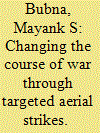

|
|
|
|
|
| Publication |
2013.
|
| Summary/Abstract |
Targeted air strikes remain a cornerstone fighting technique in modern counter-insurgency and other military operations. Yet, scholars and practitioners remain divided on the question of the efficacy of this battle mechanism. This article examines some of the underlying assumptions made in their previous analyses, and serves to nuance those approaches. Specifically, it looks at war, not as a static phenomenon but rather as a constantly evolving environment-one where such aerial campaigns affect insurgent counter-strike capabilities and decisions. Using the USled war in Afghanistan in 2008-09, the article discovers that air strikes limit non-sophisticated counterattacks but are unable to reverse a growing of sophisticated insurgent activity-a discovery that has academic and policy relevant implications.
|
|
|
|
|
|
|
|
|
|
|
|
|
|
|
|
| 10 |
ID:
115219
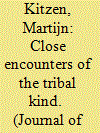

|
|
|
|
|
| Publication |
2012.
|
| Summary/Abstract |
In contemporary counter-insurgency campaigns de-escalation is typically achieved by obtaining the local population's collaboration. The rationale underlying this approach is that such collaboration spawns control over the population and therefore weakens the insurgent's position. This article seeks to understand how this approach is practised in the reality of contemporary counter-insurgency warfare. In Iraq as well as Afghanistan counter-insurgents were confronted with fragmented indigenous societies in which the various local segments were dominated by local power-holders. Consequently, obtaining the local population's collaboration required co-option of these agents. As such a strategy of co-option is a highly localized approach, this article focuses on Afghanistan's Uruzgan province and analyzes the implementation of co-option by the Netherlands' Task Force Uruzgan (TFU), which operated there from 2006 to 2010. The analysis discusses how the counter-insurgents obtained a profound understanding of Uruzgan's societal landscape and how co-option of local power-holders became part of the counter-insurgency routine. In the end, co-option was successfully implemented as TFU even succeeded in obtaining the collaboration of previously marginalized elements of the population. However, as the methods employed for co-option were mainly of a persuasive nature, the TFU co-option strategy was less effective in containing the influence of notorious spoilers. Thus this case study provides an insight into the dynamics and limitations of co-option as a tool for de-escalation in contemporary counter-insurgency warfare.
|
|
|
|
|
|
|
|
|
|
|
|
|
|
|
|
| 11 |
ID:
141152
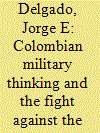

|
|
|
|
|
| Summary/Abstract |
This article attempts to place in historical perspective the latest effort by Colombia’s military (Colmil) to defeat the now half century old insurgency of the Fuerzas Armadas Revolucionarias de Colombia – Ejército del Pueblo (FARC-EP). It argues that the ‘surge’ initiated under President Álvaro Uribe in 2002 with the assistance of the United States can only be fully analyzed in the context of the Colmil’s intellectual framework for counter-insurgency. Specifically, this article will explain how the protracted engagement with counter-insurgency has shaped the Colmil’s understanding of the nature of the conflict, as well as its attitudes towards its adversary, civil authority and the instrumentality of force. An understanding of the Colmil’s strategic tradition can also help to explain their apprehensions about the ongoing peace negotiations with the FARC-EP.
|
|
|
|
|
|
|
|
|
|
|
|
|
|
|
|
| 12 |
ID:
106001
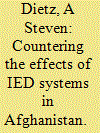

|
|
|
|
|
| Publication |
2011.
|
| Summary/Abstract |
The current approach to countering the threat of improvised explosive devices (IEDs) in Afghanistan has met with limited success. The relative lack of success may be in part because the current approach is not holistic and discounts the social systems that foster the IEDs. Insurgents are using IEDs as a tool to further their strategic aims, but the coalition and to a lesser extent the Government of the Islamic Republic of Afghanistan (GIRoA) are attacking the IEDs as if they are an end in and of themselves. Combining network disruption with information change maximizes the opportunities for mitigating the IED threat. More specifically, to mitigate the IED threat requires disrupting the social and economic systems associated with IEDs, and at the same time providing alternative economic opportunities and improving rule of law and governance at the local level. In other words, counter-IED (C-IED) must be Counter-Insurgency (COIN) centric to be successful. This paper reviews the current state of C-IED efforts, identifies five main problems with the current approach, and suggests changes to reduce or mitigate the IED threat in Afghanistan.
|
|
|
|
|
|
|
|
|
|
|
|
|
|
|
|
| 13 |
ID:
095491
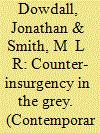

|
|
|
|
|
| Publication |
2010.
|
| Summary/Abstract |
This study examines contemporary counter-insurgency (COIN) warfare in terms of military ethics. The intention is to reflect upon the changing face of COIN conduct in the light of serious ethical challenges resulting from modern trends affecting combatant status, and the deployment of military force in a multipurpose framework. It shall engage with what many commentators have termed the 'grey area' of the Just War tradition: the ambiguous and challenging interim zone that lies in between the more clearly defined forms of COIN conduct. The resultant analysis shall suggest the need for a more nuanced form of ethical conduct, orientated around restraint, more flexible discriminatory principles and a proportionality framework closer to domestic policing than formal warfare. In particular, this analysis suggests that by hybridizing the military imperative with the policing model of the continuum of force a more effective, less vague and more ethically coherent construct can be produced. By embracing these concepts, military practitioners may overcome ambiguous and unhelpful moral guidance and tailor their conduct more closely to the challenges of the contemporary COIN environment. Such actions will assure they act as justly as possible in the face of 'grey area' ethics.
|
|
|
|
|
|
|
|
|
|
|
|
|
|
|
|
| 14 |
ID:
053312
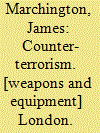

|
|
|
|
|
| Publication |
London, Brassey's, 2003.
|
| Description |
240p.
|
| Standard Number |
1857533860
|
|
|
|
|
|
|
|
|
|
|
|
Copies: C:1/I:0,R:0,Q:0
Circulation
| Accession# | Call# | Current Location | Status | Policy | Location |
| 048420 | 363.3202819/MAR 048420 | Main | On Shelf | General | |
|
|
|
|
| 15 |
ID:
138443
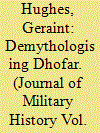

|
|
|
|
|
| Summary/Abstract |
This article re-examines the civil war (1963–1976) between the Sultanate of Oman and the Popular Front for the Liberation of Oman (PFLO), particularly the U.K.’s support of the government. Using archival evidence and private papers, it argues that the counter-insurgency (COIN) campaign’s image as “population-centric” is flawed, and that the British and Omani governments relied more on military measures against the PFLO to recapture Dhofar province than on the “hearts and minds” and civil development programmes emphasised in traditional accounts. It counsels against using Dhofar as a possible example of indirect military assistance in contemporary COIN, arguing that the conflict’s specific historical characteristics may not be replicated now or in the immediate future.
|
|
|
|
|
|
|
|
|
|
|
|
|
|
|
|
| 16 |
ID:
117630
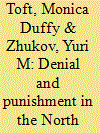

|
|
|
|
|
| Publication |
2012.
|
| Summary/Abstract |
A growing literature on the subnational diffusion of armed conflict rests on the proposition that political violence triggers more violence, in the same locality and elsewhere. Yet state efforts to contain such uprisings remain largely unexplored, theoretically and empirically. Drawing on a mathematical model of epidemics, we formalize the logic of conflict diffusion and derive conditions under which state coercion might limit the spread of insurgent violence. Using a new dataset of insurgent and government violence in Russia's North Caucasus from 2000 to 2008, we evaluate the relative effectiveness of four coercive strategies: (1) denial, which manipulates the costs of expanding insurgent activity to new locations, (2) punishment, which manipulates the costs of sustained fighting in contested areas, (3) denial and punishment, which does both, and (4) no action, which does neither. We find denial to be most effective at containing insurgent violence. Punishment is least effective, and even counterproductive. Not only does such a strategy fail to prevent the spillover of violence to new locations, but it may amplify the risk of continued fighting in contested areas. In the Caucasus, denial is found to be the least inflammatory counter-insurgency option for Russia. For it to succeed, Russia should physically isolate centers of insurgent activity from regions of nonviolence and avoid the temptation of punitive reprisals.
|
|
|
|
|
|
|
|
|
|
|
|
|
|
|
|
| 17 |
ID:
107903
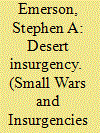

|
|
|
|
|
| Publication |
2011.
|
| Summary/Abstract |
This article provides an in-depth examination and analysis of the 2006-2009 Tuareg rebellion in Mali and Niger. It identifies the underlying reasons behind the rebellion, explores contrasting counter-insurgency (COIN) strategies employed by the two governments, and presents some lessons learned. While both COIN approaches ultimately produced similar peace settlements, the article argues that the Malian strategy of reconciliation combined with the selective use of force was far more effective than the Nigerien iron fist approach at limiting the size and scope of the insurgency and producing a more sustainable peace. It concludes by looking at the role of external actors, particularly the United States, and how the failure to internationalize the conflict was actually more beneficial to the local COIN effort, as well as to the longer strategic interests of the United States in the region.
|
|
|
|
|
|
|
|
|
|
|
|
|
|
|
|
| 18 |
ID:
116255
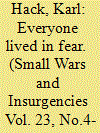

|
|
|
|
|
| Publication |
2012.
|
| Summary/Abstract |
Recent research on Palestine, Kenya, and Malaya has emphasised the coercive nature of 'Britain's dirty wars'. Abuses have been detailed and a self-congratulatory Cold War-era account of British counter-insurgency - as 'winning hearts and minds' and using minimum force - subjected to intensifying attack. The result has been a swing from over-sanitised narratives of the primacy of 'winning hearts and minds', towards revisionist accounts of relentless coercion, the narrowly coercive role of the army, and of widespread abuses. This article argues that, if Malaya is anything to go by, the essence of Cold War-era British counter-insurgency victories lay neither in 'winning hearts and minds' per se, nor in disaggregated and highly coercive tactics per se. Rather, it lay in population and spatial control in the which the interaction of both was embedded. In Malaya British tactics during the most critical campaign phases counterpoised punitive and reward aspects of counter-insurgency, in order to persuade people's minds to cooperate, regardless of what hearts felt. This article thus makes the case for avoiding artificial contrasts between 'winning hearts and minds' and a 'coercive' approach, and instead for a new orthodoxy focusing on their roles within the organising framework at play during successful phases of counter-insurgency.
|
|
|
|
|
|
|
|
|
|
|
|
|
|
|
|
| 19 |
ID:
114960
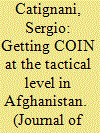

|
|
|
|
|
| Publication |
2012.
|
| Summary/Abstract |
This article reassesses the extent to which the British Army has been able to adapt to the counter-insurgency campaign in Helmand Province, Afghanistan. While adopting Farrell's definition of bottom-up military adaptation, this article contends that the task force/brigade level of analysis adopted by Farrell and Farrell and Gordon has led them to overstate the degree to which innovation arising from processes of bottom-up adaptation has actually ensued. Drawing on lower level tactical unit interviews and other data, this article demonstrates how units have been unable or unwilling to execute non-kinetic population-centric operations due to their lack of understanding of the principles of counter-insurgency warfare.
|
|
|
|
|
|
|
|
|
|
|
|
|
|
|
|
| 20 |
ID:
190716
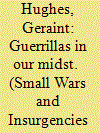

|
|
|
|
|
| Summary/Abstract |
Over the past two decades the historical record of Britain’s wars against a series of insurgencies has experienced a fundamental academic re-assessment, challenging established beliefs about how the British state and its institutions – in particular the British Army – have waged counterinsurgency, and questioning traditional presumptions that Britain fought its insurgent enemies according to a doctrine guided by ‘hearts and minds’ and ‘minimum force’. This article shows that hints about the murky reality behind the ‘British way in counterinsurgency’ can be seen in novels published during the post-war era, some of which used recent conflicts as their subject matter, others of which referred tangentially to previous wars. Not only were these best-selling books with an international audience, but these authors had experience with Britain’s armed forces and intelligence services, and were either directly involved in counterinsurgency conflicts, or their works indicated insight and knowledge about them. Their books provided fictional illustrations of many of the themes – coercive tactics against civilians, special operations against insurgents, inter-departmental disputes, the lack of cultural understanding, the maltreatment of detainees and the excessive use of force against suspected insurgents and civilians – that have been identified and examined by military historians and other academic specialists covering Britain and counterinsurgency.
|
|
|
|
|
|
|
|
|
|
|
|
|
|
|
|
|
|
|
|
|